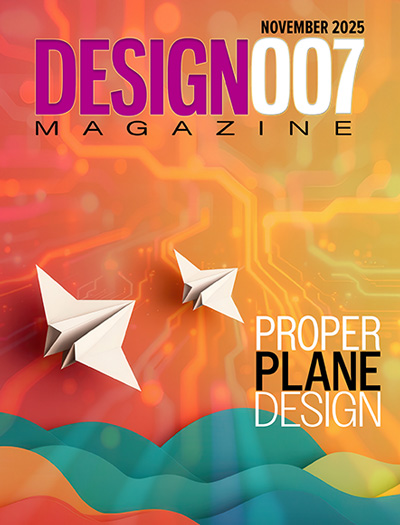-

-
News
News Highlights
- Books
Featured Books
- design007 Magazine
Latest Issues
Current Issue
Designing Proper Planes
Without planes, designers would have to create thousands of traces to accomplish the same objectives. Power planes provide low impedance and stable power, and ground planes stabilize reference voltage, improve thermal performance, and help preclude EMI issues.

Power Integrity
Current power demands are increasing, especially with AI, 5G, and EV chips. This month, our experts share “watt’s up” with power integrity, from planning and layout through measurement and manufacturing.

Signal Integrity
If you don’t have signal integrity problems now, you will eventually. This month, our expert contributors share a variety of SI techniques that can help designers avoid ground bounce, crosstalk, parasitic issues, and much more.
- Articles
- Columns
- Links
- Media kit
||| MENU - design007 Magazine
Words of Advice: Flex Design and Manufacturing Training
February 7, 2019 | Andy Shaughnessy, Design007 MagazineEstimated reading time: Less than a minute
In a recent survey, we asked the following question: Where do your technologists acquire training or expertise regarding flexible circuits? Here are just a few of the answers, edited slightly for clarity.
- We have 30 designers and maybe 1/3 of them have flex design experience. We don't have structured training for flex, but designers do share with other team mates to help.
- We work closely with our vendors to design the system.
- Training on the job.
- Learning by asking other staff members.
- Flex manufacturers generally help in the layer stack-up definition, and in design rules optimization.
Testimonial
"In a year when every marketing dollar mattered, I chose to keep I-Connect007 in our 2025 plan. Their commitment to high-quality, insightful content aligns with Koh Young’s values and helps readers navigate a changing industry. "
Brent Fischthal - Koh YoungSuggested Items
Advanced Electronics Packaging Digest: Third Issue Arrives November 17
11/12/2025 | I-Connect007The third issue of Advanced Electronics Packaging Digest launches Monday, November 17. This issue continues AEPD’s mission to deliver forward-looking analysis and insider perspectives on the technologies reshaping advanced electronics packaging. Among the highlights is a review of IMPACT 2025, where discussions on component-to-system-level integration took center stage as experts explored the challenges and breakthroughs driving advanced packaging technologies.
Electronic Design Automation (EDA) Market Size to Reach $811.1 Million by 2030
11/12/2025 | PRNewswireThe Global Electronic Design Automation (EDA) Market was estimated to be worth USD 541 Million in 2023 and is forecast to a readjusted size of USD 811.1 Million by 2030 with a CAGR of 6.4% during the forecast period 2024-2030.
The Technical Backbone of an EMS Company: A CEO’s Perspective
11/12/2025 | Jay Rupani, Precision PCBAs the CEO of an EMS company, I often say that our business runs on precision, innovation, and trust. Behind every finished product—whether it’s a medical device, an automotive control module, or a consumer gadget—lies a sophisticated technical ecosystem that makes it all possible. From design support and process engineering to automation, data analytics, and supply chain integration, the technical side of EMS is where our value truly shines.
ASE Unveils IDE 2.0 – AI-Enhanced Platform Accelerates Package Design Accuracy and Innovation
11/12/2025 | ASE GroupAdvanced Semiconductor Engineering, Inc. (ASE), a member of ASE Technology Holding Co., Ltd., announced the launch of IDE 2.0, a major upgrade to its Integrated Design Ecosystem™ (IDE) platform.
Elementary, Mr. Watson: The Four Horsemen of Copper Confusion
11/12/2025 | John Watson -- Column: Elementary, Mr. WatsonIf there were a PCB Design Dictionary of Confusing Terms, the cover would feature four words that have baffled generations of engineers: polygons, pours, planes, and floods—or what I refer to as the four horsemen of copper confusion. They sound simple, as if they belong in a geometry textbook or a weather report, but in PCB design, they overlap, develop, and sound interchangeable until you realize they aren't.


